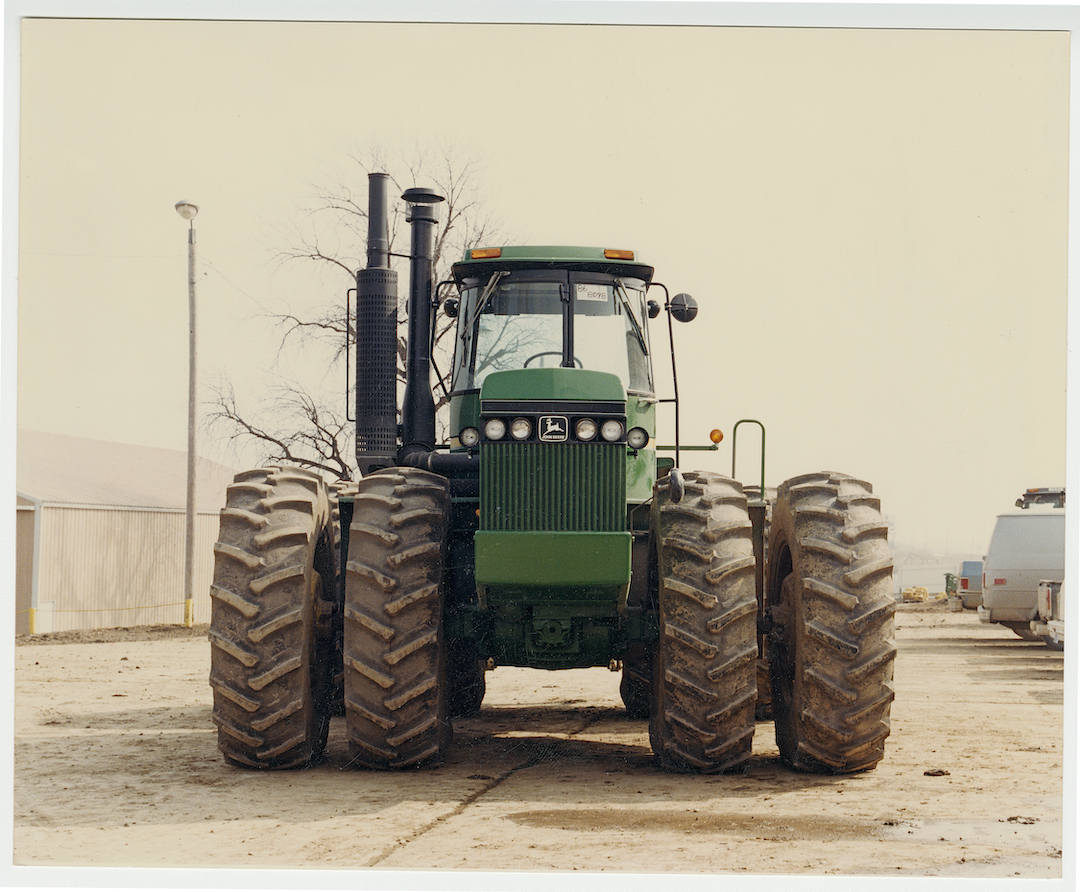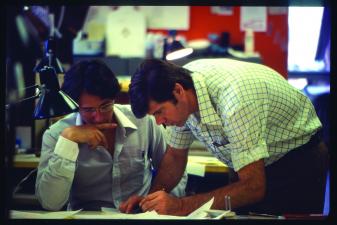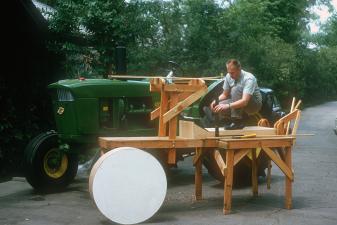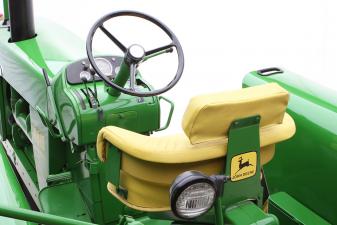John Deere Evolution: 50 Series Power Shift Upgrades

John Deere Evolution is a visually stunning work that blends tractors photographed in custom-built studios with concept drawings and behind-the-scenes looks at how the machines were designed and built. This encyclopedic history covers every model line built by John Deere since 1919. In this excerpt, written by Richard Michael, read about the revamping of the 50 Series power shift upgrades.
There was a major update to the Waterloo manufactured tractors planned for introduction in fall of 1982. With the addition of the hi-lo Power Shift and oil cooled clutches to the Quad-Range transmission, there was a need for more speeds in the eight-speed Power Shift transmission. I suggested that we could add a hi-lo planetary to the Power Shift to provide a fifteen-speed transmission. But we had to mount the clutch to the engine and let the pressure supply oil manifold float with the movement of the engine crankshaft. My eighth patent (4,373,622) showed how to provide a floating manifold for a clutch mounted to the engine crankshaft. I was the transmission project manager for the redesign of the Power Shift for the fifteen-speed transmission.
 To quiet the ComfortGard cab the transmission had o be modified. As design progressed, engineers became more aware that systems are related and simple problems can require expensive development. Photo courtesy of the Henry Dreyfuss Archive, Cooper Hewitt, Smithsonian Design Museum.
To quiet the ComfortGard cab the transmission had o be modified. As design progressed, engineers became more aware that systems are related and simple problems can require expensive development. Photo courtesy of the Henry Dreyfuss Archive, Cooper Hewitt, Smithsonian Design Museum.
SOLVING POWER HOP
In addition to the transmission upgrades, mechanical front wheel drive was developed for the 50 series tractors. In 1977, I was made Manager of Advanced Drivetrain Engineering. I had a staff of a couple of engineers capable of doing computer programming and analysis and a few design engineers working on advanced trans-mission projects.
While developing the mechanical front-wheel-drive equipped tractors, a problem called “power hop” was encountered and developed enough concern that I was assigned to a group to study the problem. Power hop is a phenomenon where the tractor starts to bounce like a ball while pulling heavy draft loads in soft, dry soils. This had been a problem with the four-wheel-drive tractors (large drive wheels that are all the same size) since the 8010 tractor was tested in 1958. A model was tested at Purdue University and mathematical modeling was done at the John Deere Technology Center without successful results. I did some mathematical modeling also without success, but I decided to look at the root locus system stability analysis from my Automatic Control Engineering advanced course. Since the problem occurred in soft, dry soil, I decided that I had to develop a model that included tire, traction, and soil characteristics as well as wheel sinkage into the soil and geometry. My stability analysis appeared to correlate well with field test results with changes in tire pressure, difference between bias and radial tires, different soils, and foam-filled tires. This seemed to verify that the problem was a system stability problem. Tests found that the system stability was very sensitive to soil moisture, even deep in the soil. In one case, in irrigated soil, it was found that a field that was slightly dryer would cause instability and an adjacent wetter field would not. It has been said that the best way to control power hop is to have a rain! My work on power hop was stopped when it was found that putting high pressure in the front tires and low pressure in the rear tires solved most of the problems.
Grab your own copy of John Deere Evolution to keep reading more about John Deere development.
There was a major update to the Waterloo manufactured tractors planned for introduction in fall of 1982. With the addition of the hi-lo Power Shift and oil cooled clutches to the Quad-Range transmission, there was a need for more speeds in the eight-speed Power Shift transmission. I suggested that we could add a hi-lo planetary to the Power Shift to provide a fifteen-speed transmission. But we had to mount the clutch to the engine and let the pressure supply oil manifold float with the movement of the engine crankshaft. My eighth patent (4,373,622) showed how to provide a floating manifold for a clutch mounted to the engine crankshaft. I was the transmission project manager for the redesign of the Power Shift for the fifteen-speed transmission.
 To quiet the ComfortGard cab the transmission had o be modified. As design progressed, engineers became more aware that systems are related and simple problems can require expensive development. Photo courtesy of the Henry Dreyfuss Archive, Cooper Hewitt, Smithsonian Design Museum.
To quiet the ComfortGard cab the transmission had o be modified. As design progressed, engineers became more aware that systems are related and simple problems can require expensive development. Photo courtesy of the Henry Dreyfuss Archive, Cooper Hewitt, Smithsonian Design Museum.SOLVING POWER HOP
In addition to the transmission upgrades, mechanical front wheel drive was developed for the 50 series tractors. In 1977, I was made Manager of Advanced Drivetrain Engineering. I had a staff of a couple of engineers capable of doing computer programming and analysis and a few design engineers working on advanced trans-mission projects.
While developing the mechanical front-wheel-drive equipped tractors, a problem called “power hop” was encountered and developed enough concern that I was assigned to a group to study the problem. Power hop is a phenomenon where the tractor starts to bounce like a ball while pulling heavy draft loads in soft, dry soils. This had been a problem with the four-wheel-drive tractors (large drive wheels that are all the same size) since the 8010 tractor was tested in 1958. A model was tested at Purdue University and mathematical modeling was done at the John Deere Technology Center without successful results. I did some mathematical modeling also without success, but I decided to look at the root locus system stability analysis from my Automatic Control Engineering advanced course. Since the problem occurred in soft, dry soil, I decided that I had to develop a model that included tire, traction, and soil characteristics as well as wheel sinkage into the soil and geometry. My stability analysis appeared to correlate well with field test results with changes in tire pressure, difference between bias and radial tires, different soils, and foam-filled tires. This seemed to verify that the problem was a system stability problem. Tests found that the system stability was very sensitive to soil moisture, even deep in the soil. In one case, in irrigated soil, it was found that a field that was slightly dryer would cause instability and an adjacent wetter field would not. It has been said that the best way to control power hop is to have a rain! My work on power hop was stopped when it was found that putting high pressure in the front tires and low pressure in the rear tires solved most of the problems.
Grab your own copy of John Deere Evolution to keep reading more about John Deere development.





